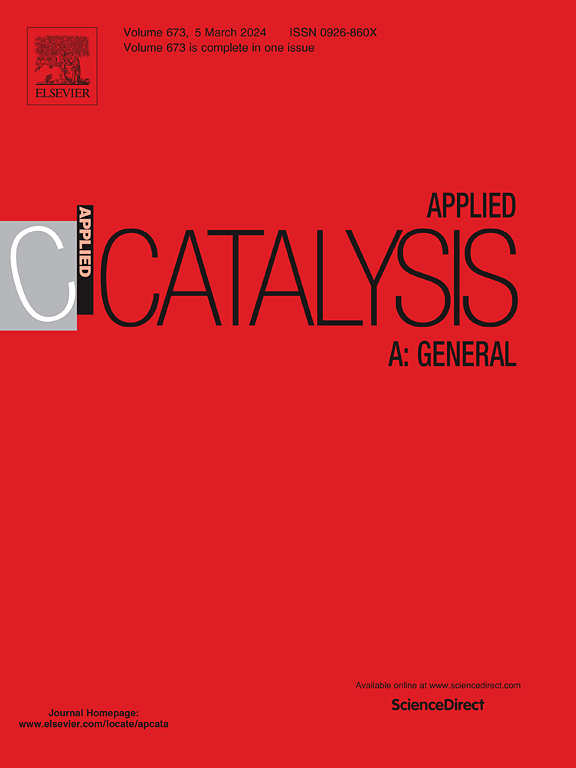磁性Fe3S4纳米颗粒水凝胶复合材料通过过硫酸盐活化有效降解农药:揭示电子转移机制的关键作用
IF 4.7
2区 化学
Q2 CHEMISTRY, PHYSICAL
引用次数: 0
摘要
本研究合成了一种磁性 Fe3S4 木质素水凝胶(FSLH)催化剂,用于激活过硫酸盐(PDS)以降解异丙隆(IPU)。该复合材料不仅能高效降解异丙隆,还能有效分解多种新烟碱类杀虫剂。实验结果表明,FSLH/PDS 系统通过电子传递途径(ETP)降解 IPU,FSLH 和 PDS 形成的 Fe(Ⅲ)-OS2O7- 复合物从 IPU 中捕获电子,促进高效降解并产生 Fe(IV)。所有活性氧(ROS),包括 SO4-、-OH、1O2 和 O2-,以及铁(IV),都有助于 IPU 降解,其中 ETP 起着主导作用。在真水基质中,增加[FSLH/PDS]的用量可显著提高IPU的降解效率,而且FSLH/PDS系统在存在各种无机阴离子和腐殖酸的情况下仍然非常有效。最终,IPU 被氧化成低毒性产物,大大降低了生态风险。该研究阐明了非自由基反应机理,为水凝胶复合纳米催化剂在农药废水处理中的应用提供了理论依据。本文章由计算机程序翻译,如有差异,请以英文原文为准。
Efficient pesticide degradation through peroxydisulfate activation by magnetic Fe3S4 nanoparticle hydrogel composites: Unveiling the pivotal role of electron transfer mechanisms
In this study, a magnetic Fe3S4 lignin hydrogel (FSLH) catalyst was synthesized to activate peroxydisulfate (PDS) for the degradation of isoproturon (IPU). The composite material not only exhibited high efficiency in degrading IPU but also effectively decomposed various neonicotinoid insecticides. Experimental results indicated that the FSLH/PDS system degraded IPU via an electron transfer pathway (ETP), wherein the ![]() Fe(Ⅲ)−OS2O7− complex, formed by FSLH and PDS, captured electrons from IPU, facilitating efficient degradation and generating Fe(IV). All reactive oxygen species (ROS), including SO4•−, •OH, 1O2, and O2•−, as well as Fe(IV), contributed to IPU degradation, with ETP playing a dominant role. In real water matrices, increasing the [FSLH/PDS] dosage significantly enhanced IPU degradation efficiency, and the FSLH/PDS system remained highly effective in the presence of various inorganic anions and humic acid. Ultimately, IPU was oxidized into low-toxicity products, substantially reducing ecological risks. This study elucidates the non-radical reaction mechanism, providing a theoretical basis for the application of hydrogel composite nanocatalysts in pesticide wastewater treatment.
Fe(Ⅲ)−OS2O7− complex, formed by FSLH and PDS, captured electrons from IPU, facilitating efficient degradation and generating Fe(IV). All reactive oxygen species (ROS), including SO4•−, •OH, 1O2, and O2•−, as well as Fe(IV), contributed to IPU degradation, with ETP playing a dominant role. In real water matrices, increasing the [FSLH/PDS] dosage significantly enhanced IPU degradation efficiency, and the FSLH/PDS system remained highly effective in the presence of various inorganic anions and humic acid. Ultimately, IPU was oxidized into low-toxicity products, substantially reducing ecological risks. This study elucidates the non-radical reaction mechanism, providing a theoretical basis for the application of hydrogel composite nanocatalysts in pesticide wastewater treatment.
求助全文
通过发布文献求助,成功后即可免费获取论文全文。
去求助
来源期刊

Applied Catalysis A: General
化学-环境科学
CiteScore
9.00
自引率
5.50%
发文量
415
审稿时长
24 days
期刊介绍:
Applied Catalysis A: General publishes original papers on all aspects of catalysis of basic and practical interest to chemical scientists in both industrial and academic fields, with an emphasis onnew understanding of catalysts and catalytic reactions, new catalytic materials, new techniques, and new processes, especially those that have potential practical implications.
Papers that report results of a thorough study or optimization of systems or processes that are well understood, widely studied, or minor variations of known ones are discouraged. Authors should include statements in a separate section "Justification for Publication" of how the manuscript fits the scope of the journal in the cover letter to the editors. Submissions without such justification will be rejected without review.
 求助内容:
求助内容: 应助结果提醒方式:
应助结果提醒方式:


